Elementary Rules of the Detective Story
In 1887, Arthur Conan Doyle unwittingly changed world literature. At the time, he was a struggling doctor, trying to build a practice and make a little money on the side. When his novel, A Study in Scarlet, was published, he launched the modern detective genre and set the standard that mystery stories follow to this day.
Conan Doyle of course had a long, rich career as a mystery writer. He even wrote several stories that debuted in The Saturday Evening Post, including “The End of Devil Hawker,” published in 1930.
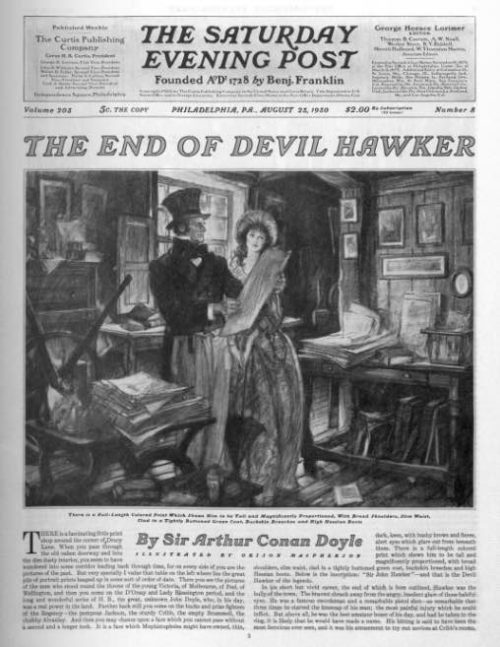
For those who wish to follow in Conan Doyle’s footsteps, in 1920, Ronald Knox wrote these rules for a group of mystery writers to help them avoid plot tricks and clichés.
- 1. The criminal must be someone mentioned in the early part of the story, but must not be anyone whose thoughts the reader has been allowed to follow.
- 2. All supernatural or preternatural agencies are ruled out as a matter of course.
- 3. Not more than one secret room or passage is allowable.
- 4. No hitherto undiscovered poisons may be used, nor any appliance which will need a long scientific explanation at the end.
- 5. No Chinaman must figure in the story.
- 6. No accident must ever help the detective, nor must he ever have an unaccountable intuition which proves to be right.
- 7. The detective must not himself commit the crime.
- 8. The detective must not light on any clues which are not instantly produced for the inspection of the reader.
- 9. The stupid friend of the detective, the Watson, must not conceal any thoughts which pass through his mind; his intelligence must be slightly, but very slightly, below that of the average reader.
- 10. Twin brothers, and doubles generally, must not appear unless we have been duly prepared for them.
In 1931, another British mystery writer added a few more rules of “respectable” mystery writing. In “Crime Fiction According to Hoyle,” Valentine Williams — another mystery writer — emphasizes that readers want a well-paced plot that is plausible, suspenseful, and finishes with a surprise.
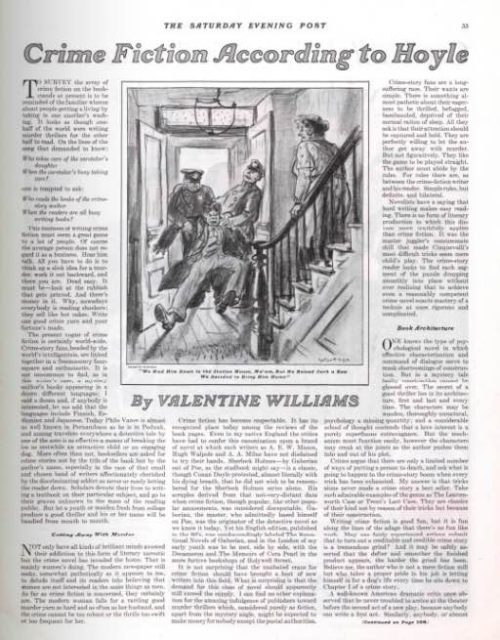
News of the Week: Baseball, Bond, and the Brig Bazaar
Leave Baseball Alone!
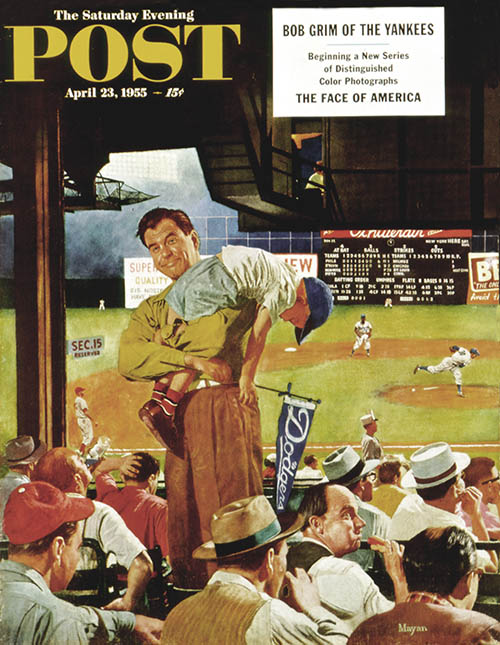
Earl Mayan
April 23, 1955
Several years ago, there was talk about improving baseball and making it enjoyable and accessible to more people. Several ideas were thrown around — some serious, some less so — but I remember two of the suggestions being 1) reduce the number of innings to seven or eight, and 2) have a foul ball count as a third strike. Apparently what is ruining baseball is that it’s just too damn long. Starting this year, baseball is going to institute a new series of rules designed to move the game along, including time limits on how long batters take to get into the batter’s box and on how long pitchers take to throw their last warm-up pitch and their first pitch to the batter, and a new rule that states the batter has to keep one foot in the batter’s box at all times. There’s also a new rule involving the use of instant replay: Managers can now demand replay from the dugout, meaning they no longer have to walk up to an umpire to challenge a play. In the past 10 years, the average time for a baseball game has gone up 20 minutes, lasting around 3 hours. The theory is if you speed baseball up more fans (and younger ones, whom I guess Major League Baseball wants to live-tweet games) will like it.
Mother of Honus Wagner, this is a bad idea. OMG, baseball is 20 minutes longer than it used to be! Yeah, well, baseball is supposed to be long and drawn out. You know why? It’s the same reason they shouldn’t tamper with tennis (another sport where they’re trying to speed things up). It’s a summer sport! Like tennis and golf, baseball is supposed to be slow and long and relaxing. I don’t care if the batters step out of the box or pitchers throw to first base a lot or the relief pitchers get a lot of warm-up throws. Baseball isn’t basketball and it’s not football and it’s not hockey. There are plenty of sports that are faster if you want that sort of thing, and I don’t hear any hardcore baseball fans complaining the sport is too slow. Actually, I think football and basketball move too slow, especially the last couple of minutes of a game when there are a gazillion time-outs, stopped clocks, reviews, and commercial breaks.
You know what makes baseball baseball? There is no clock.
Maybe one idea that could work is simply reducing the number of games played during the baseball season. Not counting the playoffs and the All-Star Game and the World Series, every team plays 162 games. Isn’t that a lot? Maybe it would be better if baseball wasn’t played until late October, when football and basketball and hockey have already started and our kids have already picked out their Halloween costumes.
James Bond Has a New Car
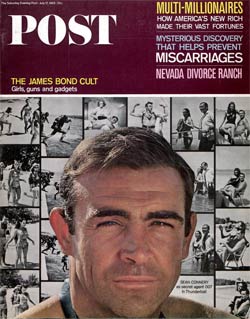
The Saturday Evening Post
July 17, 1965
If you remember the ending of the last James Bond movie, Skyfall, you’ll recall that 007’s classic, beloved Aston Martin DB5 blew up, destroyed in a heap of fire and twisted metal. It was sad, but much like killing off (spoiler alert!) Judi Dench’s M character, it gives the filmmakers the opportunity to start things fresh with the next movie, SPECTRE, which will be in theaters this November 6.
Esquire has photos of Bond’s new car. It’s still an Aston Martin, but it’s a modern Aston Martin. The DB10, a two-door with weird side windows, looks like it goes 300 miles per hour. Actually, it looks like it’s from the future. The car was made especially for the film.
And it’s not the only new car we’ll see. Bond has a car chase with someone in a Jaguar C-X75, one of five prototypes Jaguar made before stopping production a few years ago.
Lost Sherlock Holmes Story Found (or Was It?)
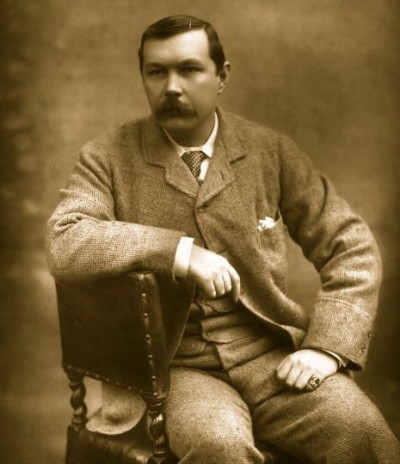
2015 seems to be the Year of Finding Lost Things. First we discovered the long-lost Harper Lee novel, Go Set A Watchman . Then came word that a new Dr. Seuss story, What Pet Should I Get?, had turned up. Now there’s news that a lost Sherlock Holmes story by Sir Arthur Conan Doyle had been discovered in a pile of books. Doyle wrote the story (with the cumbersome name “Sherlock Holmes: Discover the Border Burghs, and, By Deduction, the Brig Bazaar”) for a fundraiser to fix a damaged bridge in Selkirk, Scotland. An 80-year-old historian who lives in the town found the 1,300-word story in an anthology published in December 1903.
But wait! Now comes breaking news that some Sherlock Holmes experts doubt the story was really written by Doyle! Some scholars think the story was actually written by someone else because there is no mention of Doyle in any of the programs of the event or newspaper articles. This sounds like a case for Sherlock Holmes to solve.
Whatever the truth is, you can read the story online for free at The Telegraph .
And The Razzie Goes To…
By now you probably heard who won all the Academy Awards last weekend — and you also know what host Neil Patrick Harris looks like in his underwear — but did you hear who won the night before, during that other awards ceremony? I’m talking about the Razzies, the awards that celebrate, well, the worst in cinema. This year’s big winner (ahem) was … Kirk Cameron! The former Growing Pains star and his film Saving Christmas received four Golden Raspberry Awards, including Worst Picture, Worst Screenplay, Worst Actor, and Worst Screen Combo, an award he shared with “his ego,” as the award explained it.
Other winners include Worst Supporting Actress Megan Fox for Teenage Ninja Mutant Turtles, and Worst Actress Cameron Diaz, who was lucky enough to be singled out for her performance in two different movies, Sex Tape and The Other Woman. And Worst Supporting Actor Kelsey Grammer was called on for four: The Expendables 3, Legends of Oz, Think Like a Man Too, and Transformers 4: Age of Extinction.
There was one award at the ceremony that was actually worth winning. Ben Affleck won the Redeemer Award for going from Gigli to this year’s Gone Girl. He beat out Jennifer Aniston, Mike Myers, Kristen Stewart, and Keanu Reeves. I hope Affleck keeps this award on his mantel, next to his Oscars and Golden Globes and Director’s Guild awards.
National Strawberry Day

It seems odd to celebrate strawberries in February, but I’m sure many people are dreaming of them right now as they shovel out their driveways and knock down giant icicles that have formed on the edges of their roofs.
We have a lot of strawberry recipes, including Frozen Strawberry Pie, Curtis Stone’s Whole-Wheat Buttermilk Pankcakes with Strawberry-Maple Syrup, and even Strawberry Lassi Ice Pops.
And if you’re looking for another way to celebrate National Strawberry Day, well, they’re also great for whitening your teeth.
Upcoming Anniversaries
Lindbergh baby kidnapped (March 1, 1932)
Learn about the man who tracked down the kidnapper.
Dr. Seuss born (March 2, 1904)
Here’s a detailed biography of the acclaimed author Theodor Geisel.
Michelangelo Buonarroti born (March 6, 1475)
The artist, whose full name was Michelangelo di Lodovico Buonarroti Simoni, has his own web site, and yes it’s Michelangelo.com.
Alexander Graham Bell gets patent for telephone (March 7, 1872)
Read why the phone is one of 12 innovations that changed our world.
Famous Contributors: Sir Arthur Conan Doyle
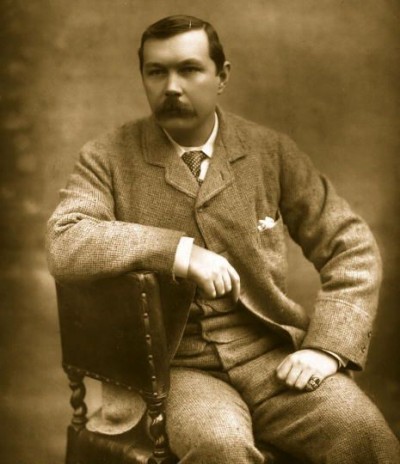
This edition of Famous Contributors to The Saturday Evening Post focuses on Sir Arthur Conan Doyle, the author of the Sherlock Holmes detective books.
His contributions to the Post include “The Death Voyage,” “The Maracot Deep,” and “The End of Devil Hawker,” [see PDF below].
Although his family’s background was in the arts, Doyle chose to focus on medicine rather than the written word as a young man. His mother took in a border named Dr. Bryan Charles Waller in Doyle’s youth, and the man had such an influence on the young boy that he decided to follow in his footsteps and go to medical school. Doyle’s own father suffered from severe alcoholism and was committed to an asylum, and in many ways Doyle looked to Waller and a future medical professor, Dr. Joseph Bell, as father figures.
At university, Bell taught Doyle the value of logic, deduction, and observation–traits that would become central to the personality of Doyle’s famed detective Sherlock Holmes. He was eventually offered a job as a ship’s surgeon on The Hope, a whaling boat bound for the Arctic Ocean. It was this voyage that instilled in him the love of adventure that was prevalent throughout his work, and was the basis for his story Captain of the Polestar.
Eventually he set up a family doctor practice and wrote stories on the side. In 1886 he began writing his big breakthrough, A Study In Scarlet, which introduced the world to the duo of Holmes and Watson. By 1891, Doyle had abandoned his medical career and was writing stories about Holmes—as well as other short stories, historical novels, non-fiction, and more—full time.
Interestingly, Doyle channeled his inner Sherlock later in life. A trial involving the wrongful conviction of George Edalji, a half-English, half-Indian man who was found guilty after blatantly discriminatory police work, caught Doyle’s attention. Doyle’s non-fictitious detective work proved Edalji’s innocence and was a factor in the creation of the Court of Criminal Appeal in England.